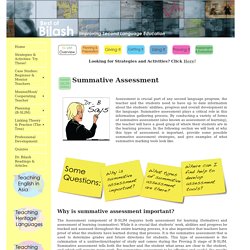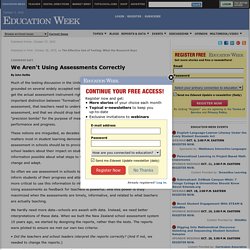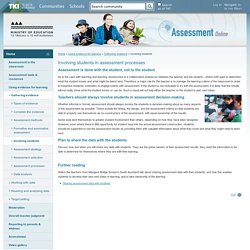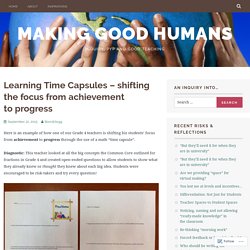

Summative Assessment. Looking for Strategies and Activities?

Click Here! Assessment is crucial part of any second language program; the teacher and the students need to have up to date information about the students’ abilities, progress and overall development in the language. Summative assessment plays a critical role in this information gathering process. By conducting a variety of forms of summative assessment (also known as assessment of learning), the teacher will have a good grasp of where their students are in the learning process. In the following section we will look at why this type of assessment is important, provide some possible summative assessment strategies, and give examples of what summative marking tools look like. » The Power of Formative Assessment. What Meaningful Reflection On Student Work Can Do for Learning.
The following excerpt is from “Authentic Learning in the Digital Age: Engaging Students Through Inquiry,” by Larissa Pahomov. This excerpt is from the chapter entitled “Making Reflection Relevant.” Characteristics of Meaningful Reflection For student reflection to be meaningful, it must be metacognitive, applicable, and shared with others. Let’s look at each of these characteristics in turn. Metacognitive Although it’s something of a buzz word, “metacognition” is a state of mind that can be useful for all the core values presented in this book. When children are first learning to reflect on their work, their educators use simple prompts to get them thinking: Do you like what you made?
Of course, there’s a danger of this metacognition turning into a kind of feedback loop: Am I reflecting adequately on my reflection? ➤ The digital connection. Applicable This kind of isolated, after-the-fact reflection dominates our understanding of the process. . ➤ The digital connection. Shared. Inquiring Naturally thru Mathematics: Using the Summative Task as the Provocation. I was struggling to come up with a provocation or ideas for our Shape and Space Unit.

We are doing a unit the looks at monuments, so I wanted to try and incorporate some kind of building or creating into the unit. This unit really made me think how about how I could make it engaging for students. We Aren't Using Assessments Correctly. Published Online: October 27, 2015 Published in Print: October 28, 2015, as The Effective Use of Testing: What the Research Says Commentary.

Involving students / Topics / Gathering evidence / Using evidence for learning / Home. You are here: Assessment is done with the student, not to the student As is the case with teaching and learning, assessment is a collaborative endeavour between the teacher and the student – where both want to determine what the student knows and what might be learnt next.

Therefore, a major role for the teacher is to manage the learning culture of the classroom in order to maximise students' motivation to engage keenly with assessment. If the student is not motivated to try with the assessment, it is likely that the results will not really show what the student knows or can do. Such a result will not help either the teacher or the student to plan next steps. Learning Time Capsules – shifting the focus from achievement to progress – Making Good Humans. Here is an example of how one of our Grade 4 teachers is shifting his students’ focus from achievement to progress through the use of a math “time capsule”.

Diagnostic: This teacher looked at all the big concepts the Common Core outlined for fractions in Grade 4 and created open-ended questions to allow students to show what they already knew or thought they knew about each big idea. Students were encouraged to be risk-takers and try every question! The teacher then tracked students’ prior knowledge on an excel sheet. This allowed him to plan full group, small group, guided and individual math inquiries based on needs. Formative: After a few weeks of inquiring into these fraction concepts, the teacher gave back the same task and highlighted questions that students were required to try (based on the concepts that had been learned over the past few weeks in class).
How to Make Grades About Students Again. Our first semester ended last week. I have been working on grades, both standards scores and letter grades, for the past 3 days. Pondering. Wondering. Pulling my hair out as I try to figure out which box to place my students in as we try to assess the growth that has happened. In the end of it all, I am reminded of how much I still hate grades. And yet, within this process of distilling my students down to a single letter comes an amazing opportunity for conversation. So how can we make grades and scores about the students again? Start with a student definition. Have them grade themselves. Have them do a semester survey. Ask them what they are proud of. Then discuss their grades. So while I work in a system that still asks me to define students through a score, we can reclaim that very conversation.
If you like what you read here, consider reading my book Passionate Learners – How to Engage and Empower Your Students. Like this: Like Loading...